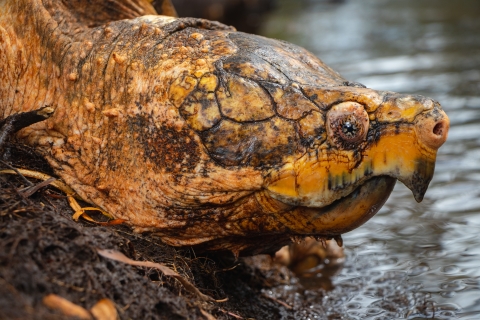The Suwannee alligator snapping turtle (Macrochelys suwanniensis), often considered the dinosaur of the turtle world, is on the decline. That’s why the U.S. Fish and Wildlife Service is listing it as a threatened species under the Endangered Species Act (ESA) with a 4(d) rule that tailors protections to support its conservation needs. The Service decided not to designate critical habitat for the turtle because it could increase poaching.
“This listing will further unite the Service and our partners in conserving this iconic species while ensuring those that rely on the outdoors for their recreation and livelihoods can continue their pursuits,” said Mike Oetker, Southeast Regional Director. “Comments and information received on the proposed listing and 4(d) rule helped to inform our final rule and we are thankful for the public and our partners’ involvement in this process,” he added.
Alligator snapping turtles are the largest freshwater turtles in North America, with males weighing more than 200 pounds. Rough, spiked brown shells resemble alligator skin with ridges running the length of the upper shell that end in a tail nearly as long as the body. A huge, wedged head supports massive jaws ending in hooked beaks. A worm-like appendage on a long narrow tongue attracts prey consisting of fish, frogs, snakes, waterfowl, small mammals, and other turtles.
The Suwannee alligator snapping turtle is only found in the Suwannee River basin of Georgia and Florida. Illegal harvest and collection, hook ingestion and entanglement from recreational and commercial fishing, and nest predation are threatening the sole population, which currently has about 2,000 individuals throughout its range.
The Suwannee alligator snapping turtle is listed as a state-designated threatened species in Florida and Georgia. In Florida, it is illegal to take, possess, or sell. In Georgia, is illegal to harass, capture, kill, sell, or purchase the species. Georgia law also prohibits the destruction of the species’ habitat on public lands.
Under the ESA’s Section 4(d) rule that tailors prohibitions to provide conservation benefits for the species, the Service will make exceptions to incidental take resulting from forest management activities that apply state-approved best management practices.
The rule, comments, economic analysis, and supporting documents are available at http://www.regulations.gov, Docket No. FWS-R4-ES-2021-0007. Persons who use a telecommunications device for the deaf (TDD) may call the Federal Relay Service at 800-877–8339.
For more information, contact Lourdes Mena, Classification and Recovery Division Manager, 904-731-3134, Florida Ecological Services Office, 7915 Baymeadows Way, Suite 200, Jacksonville, FL 32256-7517. Persons who use a telecommunications device for the deaf (TDD) may call the Federal Relay Service at 800–877–8339.
For more information see our Frequently Asked Questions.




